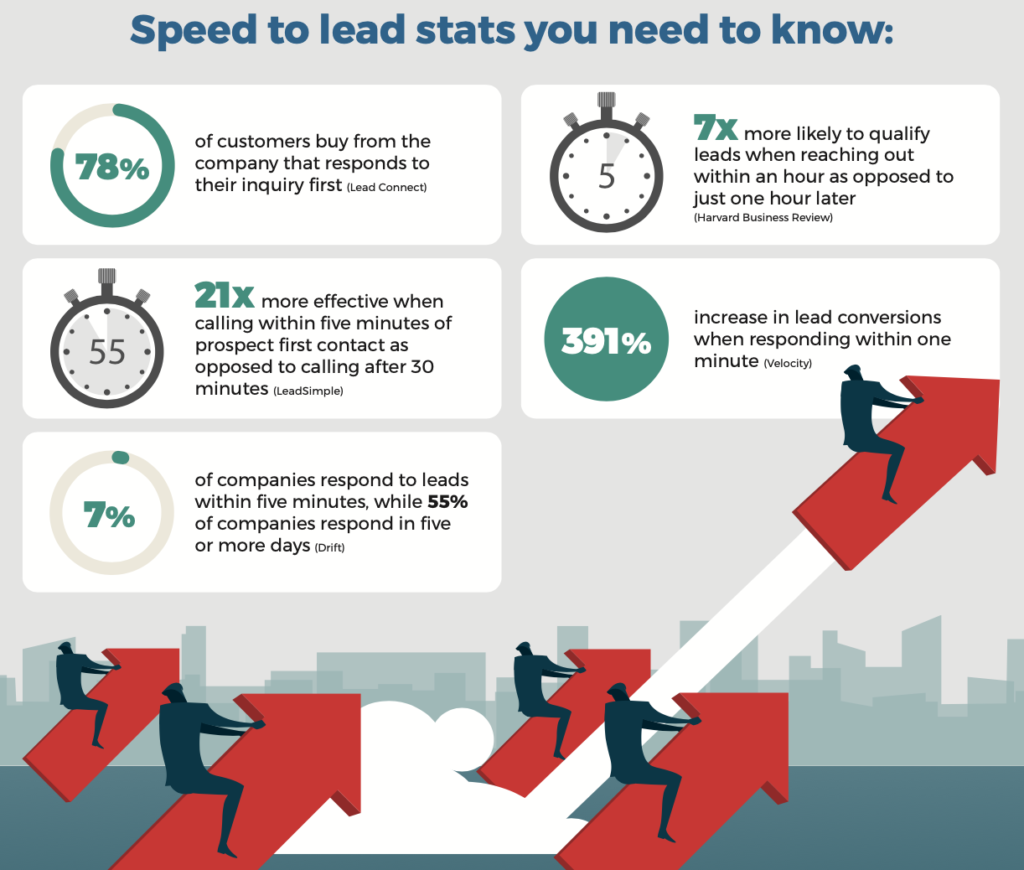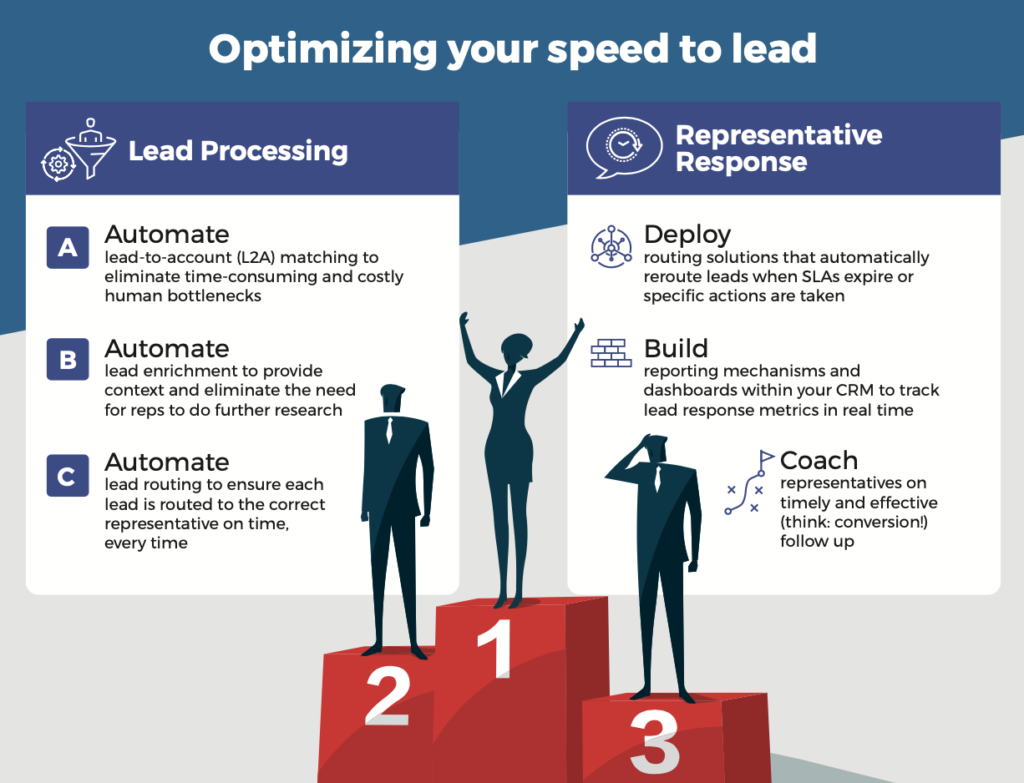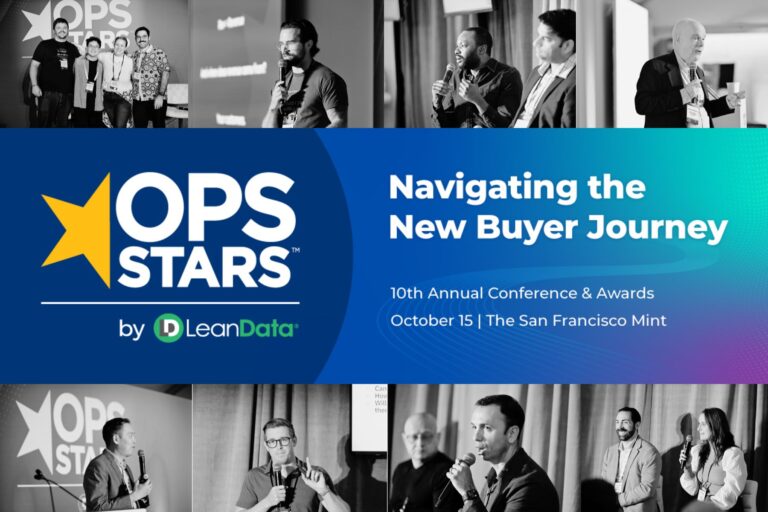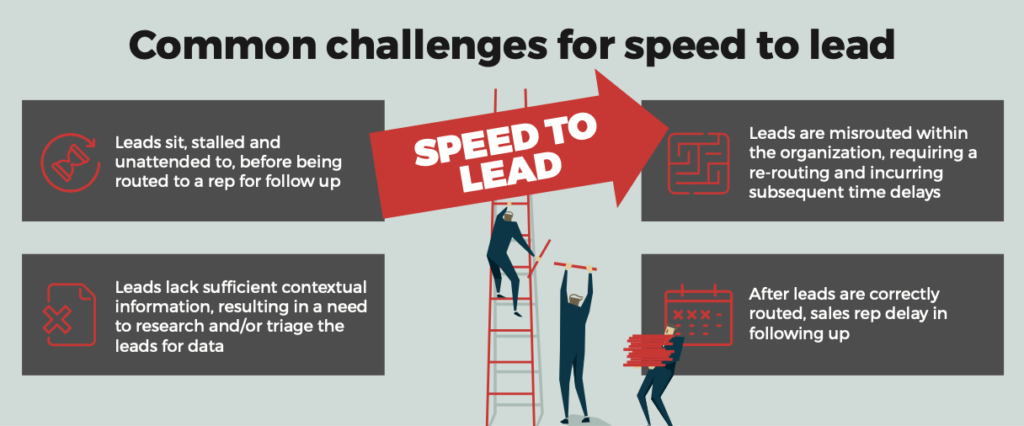When it comes to the go-to-market (GTM) race for your customer, your speed to lead or lead response time is often the single most important factor in winning or losing because speed wins!
There are no second-place consolation prizes in your Sales and Marketing motions. Your company won’t reach its objectives and your representatives won’t hit quota by finishing second.
Consider the following speed-to-lead statistics:
- 78% of customers buy from the company that responds to their inquiry first (Lead Connect)
- Businesses are 7x more likely to qualify leads when reaching out within an hour as opposed to just one hour later (Harvard Business Review)
- Sales reps are 21x more effective when calling within five minutes of prospect first contact as opposed to calling after 30 minutes (LeadSimple)
- Your odds of qualifying a lead decrease 80% after five minutes has elapsed (Vendasta)
- You are 10x less likely to have leads respond if your outreach takes more than five minutes (LeadResponseManagement.org)
- Companies experience a 391% increase in lead conversions when responding within one minute (Velocify)

Speed wins, there’s no question about it. But, as the old adage goes, you don’t have to run faster than the bear, just faster than your fellow hikers. It’s important in your market to be first, and according to Drift, only 7% of companies respond to leads within five minutes, while 55% of companies take five or more days to respond.
Thus, in many industries, there’s hope, and if you’re first, you still have an advantage. But, don’t rest on your laurels – or the shortcomings of your competitors. Your competitors are coming, and they’re coming quickly with a keen emphasis on speed to lead.
What is speed to lead?
Speed to lead is your lead response time, and it reflects the total elapsed time between prospects expressing interest in your business and their receipt of the earliest response from one of your sales representatives. Your lead response time is made up of two general components:
Lead Response Time = Lead Processing Time + Representative Response Time
As a revenue team leader, you have two levers to push and pull upon to affect your speed to lead. The first lever impacts the operations and systems that process leads and assign them to representatives for follow up. The second lever involves enabling and managing the performance of representatives responsible for follow-up accountabilities with prospects.
Common challenges affecting speed to lead
When it comes to speed to lead, companies are often their own worst enemies as their lead response times lengthen primarily through self-inflicted wounds.
Challenges generally fall into the following four classifications:
- Leads sit – stalled, unattended and unacted upon – before they’re ever routed to a sales rep for follow up
- Leads lack sufficient contextual information attached to their records, resulting in costly delays to further research and triage for missing data
- Leads are initially misrouted within the organization, requiring rerouting and subsequent time delays
- After leads are correctly routed, sales reps – for reasons ranging from workload capacity to performance issues – delay follow-up activities
Speed wins by optimizing your lead response time
In order to optimize your lead response time, you first must determine your current lead response time. Start with a reliable measurement process.
Survey your team’s actual results, by both lead type and by channel. Don’t fool yourself with averages, either. While mean lead response time is important, so is the median, the high, the low and the variance.
After you’ve assessed your current speed to lead, it’s time to get to problem-solving and continuous improvement:
- Determine root causes of poor response time by lead source, channel and outlier highs
- Establish realistic goals
- Develop your corrective action plan
- Execute, measure and analyze
- Repeat!
Remember, your lead response time consists of two components – processing time and rep response time. To optimize total speed to lead, you need to optimize both sides of the equation.
Solving for lead process time
Lead processing time must be both fast and accurate. For most every organization with any meaningful volume of leads, automation is the most efficient and cost-effective method to process leads.
Automated lead-to-account matching solutions match Inbound leads to any existing account in your Salesforce CRM. Additionally, contextual account data can be further added with enrichment solutions like ZoomInfo, also easily integrated into your tech stack.
Holistic view of leads and accounts eliminate any need to fill in data gaps, empowering sales reps to engage immediately with a new prospect. Instead of researching and data entry, your sales professionals promptly get to selling-related activities.
Next, automated lead routing solutions ensure the right leads get to the right representatives at the right time, every time. Automating any manual lead routing processes eliminates operational bottlenecks and human errors, and it ensures no leads get left behind, either lost or completely forgotten. Build your routing flows to prioritize the routing of time-sensitive leads first – for example, demo requests need immediate routing, while less urgent trade show booth visitors can be slotted in behind.

Holding your sales reps accountable
Once leads are routed, your sales reps are then accountable for following up and closing the lead response cycle. Your automated technology tools help here as well.
LeanData’s lead routing solution allows round robin assignment of leads, complete with a variety of useful filters. Experienced reps, for instance, usually have higher ability and capacity, and therefore can effectively handle a larger lead load than new reps. Additional filters include expertise, be it product, language, industry, or other; work and vacation schedules, territories, time zones and more. Round robin assignments maximize your team’s effective capacity by optimizing distribution.
Furthermore, LeanData routing workflows can be built with Hold Until nodes, where leads are held until a defined time limit expires or another specified condition is met. Once a record meets the conditions; for example, the Lead Status field is changed or the time limit expires, the record is automatically directed to the next node in the lead flow. In the case of a time limit expiration, the lead is routed to another rep, triggering automated notifications to both the rep and the SDR manager.
Finally, time-tracking functionality automates reporting on lead response time, making reports directly accessible from within Salesforce, empowering reps and managers to learn and improve upon both process and performance.
Provide a better customer experience
Engaging your leads quickly provides a better customer experience for your prospects. They’re requesting action, and you need to respond promptly, for what’s good for customers is good for your business. The marketplace is competitive, and speed wins more often than not. Use proven processes, systems and tools to improve speed to lead and maximize your Sales and Marketing strategies.










